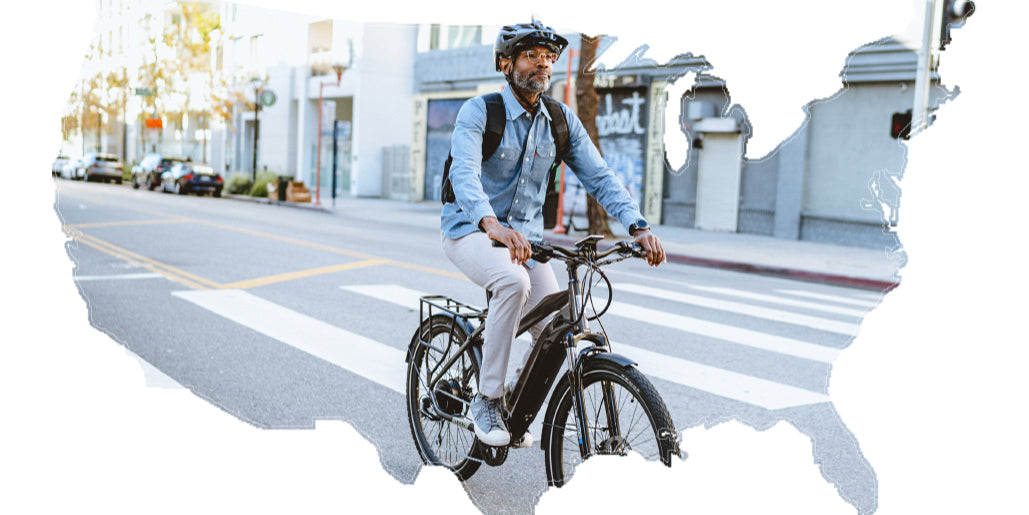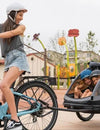
Ebike Laws and How They Impact Riders | Aventon Bikes
April 17, 2020
As ebikes become more popular and commonplace in the United States, we understand that there might be some confusion around ebike laws throughout the country. Are electric bikes street legal? And if so, what are motorized bicycle laws by state and do you need a license to drive an electric bike? Electric bike laws vary by individual state and jurisdiction and it is a multi-layered and complex subject that can be intimidating to newcomers. As experts in the ebike industry, we want to help everyone better understand ebike laws and how they differ depending on where you live in the US. We hope to clear up some confusion with the information in this blog.
The most frequent question we get asked is: how are ebikes classified and how do they differ in each state? The first question is much easier to answer than the second one.
There are three classes of ebikes that were established by People for Bikes based on important factors such as motor, pedal assistance, wattage, and operational rules.
CLASS 1
CLASS 2
CLASS 3
The initiative to create a uniform ebike classification throughout the country was spearheaded by People For Bikes, a non-profit organization that educates and advocates for bike safety and bike infrastructure throughout the country. In 2015, they launched a national campaign to pass ebike legislation in all 50 states. Passing sensible e bike laws are beneficial to ebike access, it builds communities of like-minded individuals to find alternative transportation solutions, encourages people to drive less motor vehicles, reduce carbon emissions, and is good for local businesses.
The end goal for People For Bikes is that all classes of e-bikes are defined in every state with similar access to the road and shared bike infrastructure. This is accomplished by implementing four main objectives:
- Outdated vehicle regulations are updated to reflect technological advances.
- Low speed e-bikes are regulated similarly to traditional bicycles.
- Consumers and retailers are not confused about electric bike laws by state.
- The public is encouraged to take advantage of the benefits that a street legal electric bike has to offer.
However, the issue gets more complicated because of varying electric bicycle laws by state with this classification. From People for Bikes: “In many states, e-bikes lack a specific vehicle classification and it is unclear how they are regulated. They may be interpreted to fall within terms primarily aimed at combustion engine vehicles such as mopeds or scooters. Our goal is to clearly define e-bikes and provide sensible roles for their use.”
People for Bikes has made significant progress. At the time of this writing, “Nearly 30 states have incorporated e-bikes into their traffic codes and regulated them similarly to traditional bicycles. However, approximately 20 states still have outdated laws that lack a specific classification for electric bicycles.”
Model ebike legislation also means that:
- E-bikes are not subject to the registration, licensing, or insurance requirements that apply to motor vehicles.
- All ebike manufacturers must apply a standard label to each e-bike specifying its type and wattage to help law enforcement agencies determine if an e-bike has access to a particular bikeway.
- Persons under 16 years of age are not able to ride a Class 3 e-bike (unless as a passenger).
- Helmets are required for riders of Class 3 e-bikes.
- The same rules of the road apply to both e-bikes and human powered bicycles when it comes to speed, proper passing, local traffic laws, speed limits, equipment and other ordinances.
Ebike use is further complicated by electric mountain bikes (eMTB) because trail use varies by the fact that you could be riding on federal, state, county, or even privately owned property. We highly recommend that you check with local authorities to make sure that you are not violating any land use while riding your eMTB. Generally speaking, any natural open trail that is available to motorized and non-motorized vehicles is also open to electric mountain bikes. As a general rule, do not ride on roads where the rules are unclear. Practice good citizenship and be stewards of the trails by respecting trail rules and regulations such as the electric bike speed limit as they can change frequently.
Also note that a motorized bicycle is not the same as a moped or scooter, and the motorized bicycle laws by state do not cover operation of the latter two.
In general, if you are unsure about the ebike laws where you live, we highly recommend that you check with your state, city, and local jurisdictions. Don’t be surprised if city officials or local law enforcement officers are uncertain themselves. This is because ebike laws are generally not top of mind to law enforcement and officials.
We are blessed to be a California-based company where the ebike laws are more clearly defined as a model legislation state, but many other states are not as fortunate. One state, in particular, New York, has been in the news lately because ebike laws there have been changing at a frequent and rapid pace. In June 2019, the New York state senate passed a bill legalizing ebikes and e-scooters by an overwhelming majority. However, in December 2019, Governor Andrew Cuomo vetoed that bill. As it stands now, here is where the ebike law in the state of New York stands:
The new New York e-bike law:
- Defines Class 1 and 2 e-bikes consistently with the model legislation and provides those riders the same rights and duties as traditional bike riders.
- Defines Class 3 e-bikes as a throttle-actuated e-bike with a top motor-assisted speed of 25 mph, only allowed to operate in New York City. Class 3 e-bikes are technically not allowed to operate in the rest of New York State.
- Does not define Class 3 e-bikes consistently with industry standards (a pedal assist e-bike with a top motor-assisted speed of 28 mph).
- Allows Class 1 and 2 e-bike riders to:
- Ride on roads with speed limits of 30 mph or less, including bike lanes.
- Carry passengers.
- Provides cities and towns the authority to prohibit e-bikes or require helmets and reflective clothing.
- Note that PeopleForBikes is seeking clarification from state authorities with respect to what bike paths e-bike riders may access.
The new West Virginia e-bike law:
- Defines Class 1 and 3 e-bikes consistently with the model legislation and provides those riders the same rights and duties as traditional bike riders.
- Does not define Class 2 e-bikes. Class 2 e-bikes are technically not allowed to operate in West Virginia.
- Allows Class 1 e-bikes on bike paths and multi-use trails.
- Requires that passengers on Class 3 e-bikes under the age of 15 must be on an e-bike driven by someone 18 years or older.
- Allows a city, town or state agency to restrict where e-bikes are allowed.
We highly recommend that you visit the People For Bikes website to keep up with the latest news on motorized bicycle laws by state. To help you decide which ebike is appropriate for you, we’ve put together our best-selling ebikes and their respective classification. All of our ebikes have Class decals on them to help you (and the officials in your area) identify their appropriate road and trail use.
Class 3 Ebikes
Class 2 Ebikes
Our customer support team is more than happy to answer any questions you may have about ebike classes and will help you find the perfect ebike that fits your style of riding. You can contact our support team by visiting our support page.
Enjoy safe riding!








